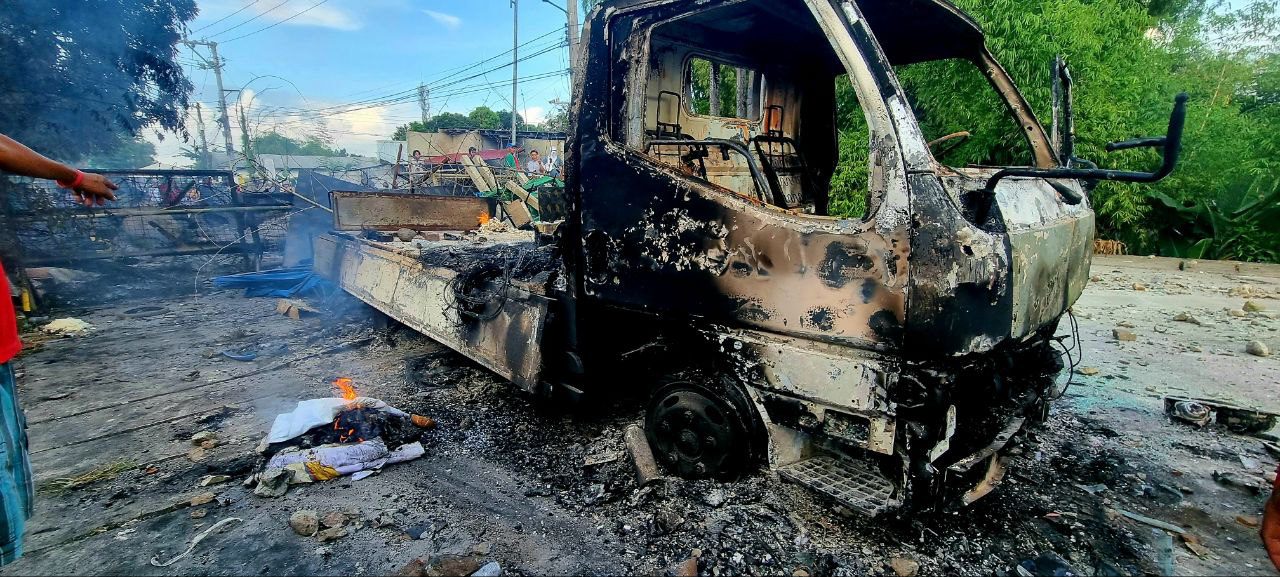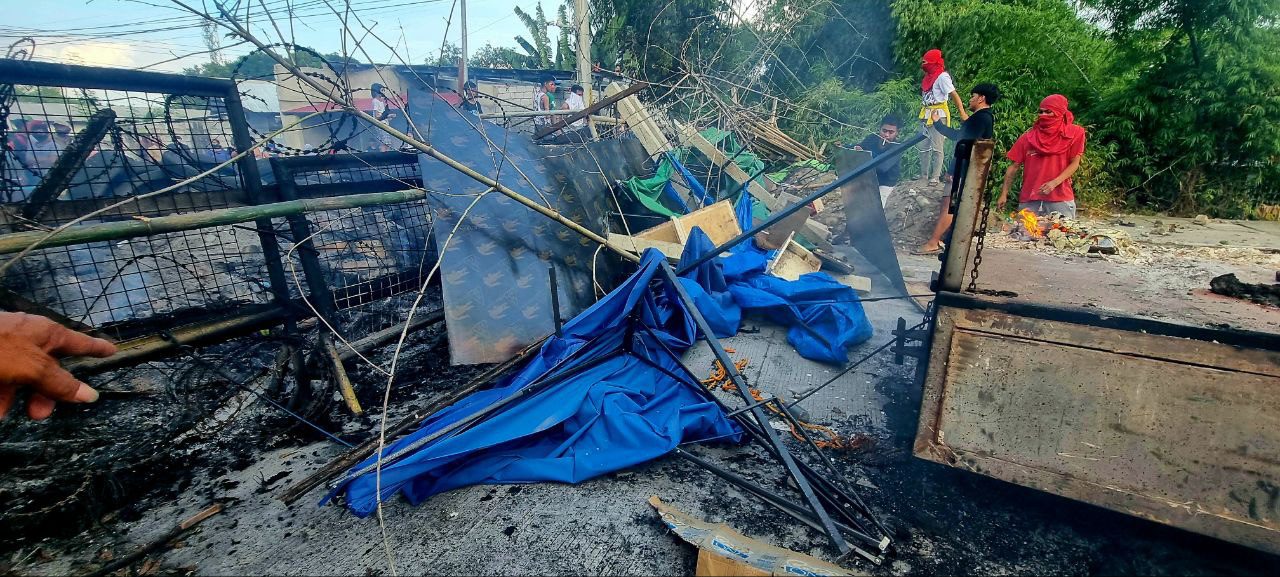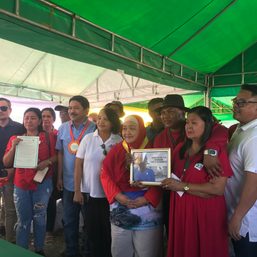SUMMARY
This is AI generated summarization, which may have errors. For context, always refer to the full article.

ANGELES CITY, Philippines – Farmer Eduardo Pangilinan, 58, has been living in Barangay Anunas of this city all his life. He was once part of the 1987 farmers’ march protest that ended up as the Mendiola massacre.
Paid for with sweat, tears, and blood, the struggle for land in this part of Pampanga province paid off in 1998 and 1999 when Pangilinan’s father, Eleuterio, received his Certificate of Land Ownership Award (CLOA) title from the Department of Agrarian Reform (DAR).

He was one of 47 farmers in the area who got CLOAs under then-president Fidel V. Ramos and later, Joseph Ejercito Estrada.
Eduardo took over the land when his father died. By 2017, he had fully paid the P455,000 agrarian mortgage. He received a certification of full payment in 2020 from the Landbank of the Philippines.
Until this year, the Pangilinan family still farmed their five hectares, mostly with sugarcane and sweet potato.
But the promised land is now under siege by a developer after the DAR canceled the hard-earned titles of dozens of farmers.
Once more, Eduardo and his peers are fighting for economic justice.
Violent demolition
Fumes from burning tires wrapped the air along Balubad Street in Barangay Anunas around noon on Monday, October 16, as residents defended their homes against a demolition escorted by Angeles police personnel.
The violence was captured on a Facebook Live video. Authorities used a truck and clamp to tear down the residents’ barricade. It was burned down during the skirmish.
Eduardo’s daughter, Charmaine, told Rappler following the demolition that it would continue until October 19, with another round from November 6 to 10.
“Si Mayor di na pinakikinggan. Nag-start na sila. Pati sina Mayor binastos na. Kasi nagpadala na si Mayor ng letter sa kapulisan, lahat ng ahensiya, pero sila pa rin ang nagpadala dito,” said Charmaine.
(They did not listen to Mayor. They pushed through with the demolition. Even Mayor has been disrespected. He already sent letters to the police and all agencies, but they still sent the demolition team.)

Agrarian reform beneficiaries are not the only ones affected by the demolition. The disputed area sprawls across 73 hectares now claimed by Clarkhills Properties Corporation.
A portion remains agricultural land; Eduardo’s family still farms their plot. Some areas have been occupied as residential properties through the years.
All in all, some 2000 residents face the loss of their properties.

City intercedes
On October 16, Angeles City Mayor Carmelo Lazatin Jr. said the city will expropriate the disputed land to prevent dislocation of residents.
In a press release, the mayor said he has also sent a letter to President Ferdinand Marcos Jr. to stop the demolition of the properties in Barangays Cuayan and Anunas, and to negotiate and renew the discussions with Clarkhills and the Department of Agrarian Reform Adjudication Board (DARAB).
In his letter, Lazatin acknowledged the court order for the demolition. But he appealed for more time for humanitarian considerations.
The mayor wrote to DARAB Sheriff Elizabeth Marasigan on October 13.
“Our plea fell on deaf ears,” he said, as Marasigan replied that only a temporary junction would halt their operation.
The mayor said the city was “left blindsided” by a development that could worsen unrest.
“No one should be denied decent housing. We are appealing for compassion from the Clarkhills management,” said Lazatin.
Undersecretary Elpidio Jordan Jr., chairperson and CEO of the Presidential Commission for the Urban Poor, was also sent a copy of the letter.
Lazatin has offered to purchase the property occupied by the tenants under the city’s socialized housing project.
The developer’s president, Oscar Torralba, denied any agreement about a development plan and relocation, but pledged financial aid for affected residents.
How did farmers lose their land?
Eduardo said they only learned their CLOAs had been canceled through the Registry of Deeds (RD) in 2020, at the height of the COVID-19 pandemic.
“It triggered our fear because of course, this is our land ever since we have been farming here,” Pangilinan told Rappler in an interview on Sept. 25.
“We have been wondering why they canceled our CLOAs. In 1991, the mother title was mortgaged but the government still awarded us the CLOA in 1998 during the time of presidents Estrada and Ramos.”
Rappler verified the cancellation of one of the farmer’s CLOAs of the farmers at the RD.
According to Clarkhills lawyer, Gener Endona, one of the reasons for the CLOA cancellations was the classification of the 73 hectares as residential land.
Endona acknowledged sending a letter to the RD requesting for the CLOA cancellations. He said the case dates back to 1997.
“Kasi yung land 73 hectares, I think, na-cover ng CARP despite being a residential land. Question nung owner ‘yan dahil nga dapat hindi ‘yan coverage, nasa housing project dapat ‘yan,” he told Rappler.
(The 73 hectares were placed under CARP despite these being residential land. The owner questioned that because the land should have been used for a housing project.)
He said the DAR Pampanga canceled the CLOAs. The beneficiaries appealed to the DAR’s Central Office, the Court of Appeals, and then the Supreme Court (SC).
The March 2001 SC ruling said the CLOAs were issued under questionable circumstances and therefore, a cancellation was in order. The High Court denied the petitioners’ motion for reconsideration.
Endona added that in December 2007, a manifestation was filed to inform the Supreme Court that the petitioners would no longer file a petition for review.
Renewed struggle
Lawyer Dairen Canlas, a private practitioner and former Patrol Partylist chief of staff, now stands on behalf of the affected farmers.
She told Rapler on September 21 that several lawyers had previously represented her new clients, and acknowledged there could have been possible lapses.
Canlas stressed the situation is an issue of social justice for the affected families.
“We are talking about possibly displacing 2,000 families in Balubad, Barangay. Anunas. This is about social justice. No one is really helping them,” said Canlas.
She added that they are currently “reconstructing the records by requesting [from] different agencies including DARAB, the provincial agrarian reform adjudication board, and the Supreme Court.
“We’re giving them hope and, at the same time, fighting so they won’t be displaced without any solution as to where they will be relocated,” she stressed. “There is no clear plan where they will be relocated,” she added.
Rappler’s interview with Canlas happened after a demolition that tore down on September 21 four residential houses, one commercial laundry warehouse, and a furniture factory on Balubad Street, Purok 1.
The operation was covered by a writ of execution by Marasigan. The immediate area of the October 16 demolition comprises 500 households.
Joy Paragas, one of the affected residents, said their group still has a June 2023 pending motion to quash with a preliminary injunction, and a petition for prohibition of the demolition.
Race against time
The first demolition followed the mayor’s September 15 and 16 meeting with Marasigan, Clarkhills representatives, members of the city police, barangay officials, and the homeowners.
Lazatin and city chief adviser IC Calaguas also met with Clarkhills president Torralba, asking for the timeline of development and the city’s possible procurement of the lots occupied by the residents, and the relocation and distribution of financial assistance to others.
“We asked them to provide three things: one, the status quo, at least on the residential side, not on the farmland. Second, we asked them if they could sell the residential lot to the city government under the urban poor program, to which they said they would think about it. Third, we were asking for relocation and financial assistance. To which they said okay, they are open to that,” Calaguas told Rappler on September 21.
But that discussion never ended up on paper, leading to the violence of October 16.
Rappler tried to reach DAR Pampanga Provincial Office and DAR Central Office several times, but no response has been provided as of this writing.
Even if Lazatin manages to get a stay on the demolition of residences, farmers in this slice of Central Luzon face the biggest agrarian reform travesty – the loss of promised land they have paid for through decades of hard work. – Rappler.com
Add a comment
How does this make you feel?

















![[ANALYSIS] Not all REITs are created equal](https://www.rappler.com/tachyon/2024/06/tl-not-all-reits-are-created-equal-06012024.jpg?resize=257%2C257&crop=233px%2C0px%2C720px%2C720px)
There are no comments yet. Add your comment to start the conversation.